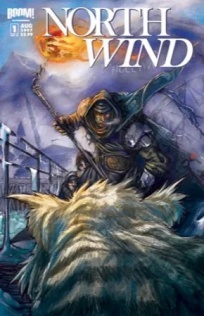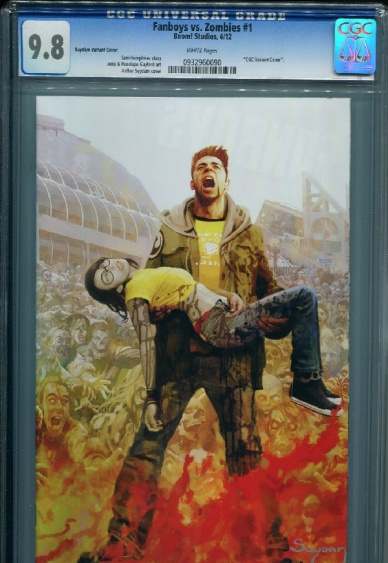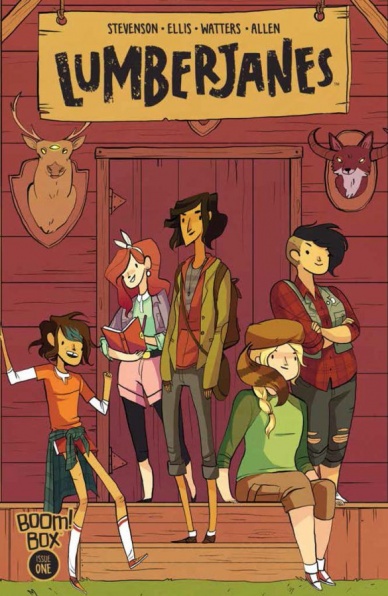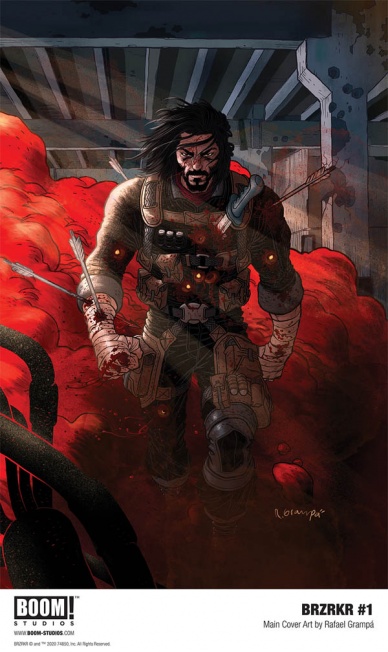This week is BOOM! Studios’ 17th birthday, and the only way Multiversity’s history column knows how to celebrate is with a special article covering the life of the company.

The story of BOOM!’s founding starts in 1993, when Ross Richie was 22 and fresh out of film school. He found a job with the marketing department of Malibu Comics right when they were kicking off the Ultraverse, and his primary function was to implement the ambitious plans for ads on bus stops and television. While there, he met the slightly older Andrew Cosby and the two became close friends over the next two years. Marvel bought Malibu in November 1994, and in 1995 both Richie and Cosby found themselves downsized. (Or they quit. Sources conflict. Maybe one quit and the other was downsized.) Cosby moved on to produce television shows, and Richie went into consulting and script reading. He spent a good deal of the late 1990s working to get Matt Wagner’s “Mage” brought to film.
During that time, Richie became friends with comic creator Keith Giffen. Giffen invited Richie to co-write a series for Image, with Giffen penciling. Richie initially refused, believing he would do a terrible job. Giffen kept pushing until he relented. The first issue of “Dominion,” a cynical take on typical superhero archetypes, was released January 2003. The series was billed as an ongoing with the second issue solicited for February, but it didn’t ship until May. The delay was probably due to production troubles because the second issue was inked by Dave Elliot instead of Claude St. Aubin, as originally planned. Between low initial orders, lost interest from the late shipping, and the presumed difficulties behind the scenes, there was no third issue.
As disappointing as that venture probably felt at the time, it would change the rest of Richie’s life. Elliot, the replacement inker, also happened to be a co-founder of Atomeka Press, a comic publisher that had a respectable run from 1989 to 1997 and a false start return with an issue of “Maximum Force” in 2002. While working on “Dominion,” Elliot shared his plans to revive the dormant company and Richie thought it sounded fun. He brought in Cosby, and the group successfullly jumped started Atomeka in 2004 with a variety of one-shots and specials. Giffen, who was also working with Atomeka, was impressed by Richie’s business sense and encouraged him to branch off as an independent publisher. With input from Mark Waid, a partnership with Cosby, and some venture capital from Cosby’s in-laws, Richie gave it a try.

About a month later, on July 27, came the first comic carrying only the BOOM! logo. “Hero Squared” was a three-issue miniseries by Giffen, which followed a one-shot published by Atomeka the previous year. It was the first of many creator owned works to migrate from other publishers that year. BOOM!’s immediate appeal, aside from Richie’s industry contacts, was the way it positioned itself in its contracts.
Fans often divide comics into company-owned and creator-owned works, but lost in that dichotomy is the nuance of what creators get to own. At Image, where creators retain everything, creators also produce their work on spec and are responsible for all advertising. At BOOM! , where the company retains a larger partnership stake in profits, creators take on less risk and receive more help on the front end. Other publishers slice the various rights in different ways.
The influx of talent was fast enough, and great enough, for BOOM! to be named the year’s Best New Publisher by “Wizard.”
Continued below2006 was an exciting sophomore year for BOOM!. Their four-issue miniseries “Talent” by writers Christopher Golden and Tom Sniegoski and Paul Azaceta debuted in May 2006, and by August there was a five-way bidding war for the film rights. Another mini, Keith Giffen and Kody Chamberlain’s “Tag,” also attracted Hollywood interest. By the end of the year, both had been picked up by Universal Studios, bringing both BOOM! and the creative teams a nice bonus. The company also branched out into licensed work for the first time with “Warhammer 40,000” one-shots.
In 2007, BOOM! was up to a staff of five, working with a team of freelancers to put out about 12 comics per month. All the releases were either one-shots or mini-series, with most issues selling between 5,000 and 10,000 copies. The big hit of the year was Steven Grant Art by Mataes Santolouco’s crime adventure “2 Guns.” At an SDCC panel plagued with technical glitches, several big announcements were made. The biggest was Mark Waid’s new role as Editor in Chief, along with a new standard format of 5-issue minis with a long-term focus on getting the collected editions into bookstores.

Long running plans for an imprint aimed at kids finally came to fruition in early 2009. First announced as Zoom, the publisher launched BOOM! Kids following a licensing deal with Pixar. New stories starring the characters from Incredibles and Toy Story brought in new readers from a segment of the market that was underserved at the time. The shine on the Pixar / Disney deal came off quickly, however, when Disney announced its plans to buy Marvel later in the year. BOOM! ‘s license ran through its planned three years, but it wasn’t renewed. That’s unfortunate in hindsight, because BOOM! ‘s licensed work for Disney was mostly great, and Marvel’s attempt at it was so pitiful that after a few years the IP was licensed to IDW Publishing. BOOM! Kids continued with other material, and was rebranded as KaBOOM! in 2011 to make it more appealing to all ages.
A second big change for BOOM! in 2009 came with the release of “Irredeemable” by Waid and Peter Krause. The title, which was about a Superman expy going rogue, was BOOM! ‘s first ongoing and brought a new wave of attention. It was BOOM! ‘s top seller for the month, and the first reprint volume was the 46th highest-ordered trade paperback for the year. It went on to receive nominations for three Eisner and two Harvey Awards. A spin-off, “Incorruptible,” debuted just seven months later.
The one-two punch of BOOM! Kids and “Irredeemable” in 2009 earned BOOM! it’s first Diamond Gem award for best pub under 4% market share, an award that practically became an annual tradition going forward.

The company hierarchy experienced a shakeup when Waid moved from EIC to Chief Creative Officer in August, replaced by longtime Managing Editor Matt Gagnon. Four months later, Waid left BOOM! s staff entirely. He stayed on as a freelancer, finishing his run on “The Traveler” in 2011 and concluding “Irredeemable” and “Incorruptible” in early 2012.

Despite BOOM!s rapid growth and success, too many fans and retailers still saw the publisher as a scrappy underdog instead of a viable top 10 contender. They wanted that to change, so they launched a “We are BOOM!” PR campaign in 2013. Naturally, that included a revised company logo that was shown to retailers at the ComicsPRO summit, then to fans at Emerald City ComicCon in February. As part of the campaign, BOOM! changed its standard launch plan for new series, which had previously included a $1 first issue. Experience had shown them that retailers weren’t ordering it any higher and second issue numbers were unaffected by it, with the end result being that they were cheating themselves and retailers out of extra profits. They scaled back the variant/incentive programs. They also tried to change the way they presented new series to fans, with some announcements from high-profile creators like Mike Carey (“Suicide Risk”) and Brian Stelfreeze (“Day Men”).
In June 2013, BOOM! acquired Archaia Entertainment, a small publisher who cornered the market on high-quality production value. The addition of Archaia’s backlist books at BOOM! Boom’s SDCC booth a month later made their offerings more impressive to passerby Fox executive Mark Roybal. He picked up the most appealing ones and, after reading them, initiated a 6-week negotiation that ended with an agreement signed October 1st. The deal gave 20th Century Fox the first look at BOOM! ‘s material for film and television. While not the first of its kind (a Universal-Dark Horse deal was made earlier), it was an amazingly sweet deal, giving BOOM! a cut of the first-dollar gross. Because of the way BOOM! had styled its contracts as a partnership, those earnings are split 50-50 between BOOM! and the adapted comic’s creator(s). Former Archaia EIC Stephen Christy became BOOM! s Direct of Development with the job of actively getting those adaptations made.
The following year, former DC runner Paul Levitz joined BOOM! ‘s board of investors. He brought years of experience with him, and uses it to help structure creator deals and value acquisitions.

The next few years saw more successes come BOOM! ‘s way. In 2015, they won their seventh consecutive Diamond Gem award for best small publisher. In 2016, they launched “Mighty Morphin Power Rangers,” which has remained their most consistently best-selling book. They also saw Loot Crate boost orders for the “Big Trouble in Little China / Escape from New York” crossover by about 400,000 copies. In 2017, they initiated a retailer-outreach program that made six titles per month returnable with no strings attached. Later that year, 20th Century Fox bought a minority share of BOOM! For $10 million.
Continued belowAll this built to February 2018, when BOOM!’s arrival was acknowledged in a really big way as Diamond Distribution crowned BOOM! and Dynamite Entertainment as premiere publishers effective in May. This exclusive club is reserved for the biggest and most important publishers, having been expanded only one other time since it was instituted in the mid 1990s. The distinction was one Richie had been asking for since 2010, and Diamond had finally agreed with him.
The deal included new multi-year agreements that were largely the same as previous ones, but they came with the hope of great growth. Diamond’s catalog presents the premiere publishers first with customized, spacious layouts, then crams everyone else into alphabetical listings that are mostly cookie cutter-like in their design. BOOM! President Filip Sablik shared his belief at the time that 40-50% of retailers ignored the alphabetical section, suggesting the move to the premiere section would drastically BOOM! ‘s sales. Actual growth turned out to be quite minor, with the average monthly market share barely changing over the next two years compared to the two year period prior to the change. Meanwhile, the monthly output shrank from 24 issues a month to 22.
In 2019, BOOM! signed a high-profile deal with famed children’s author R.L. Stine for four graphic novels. The first, “Scare School,” was heavily promoted and became the company’s best-selling graphic novel with initial orders over 200,000. At the time, Bleeding Cool suggested it might be the best-selling graphic novel for any American publisher, but a claim like that has to come with many caveats – otherwise, “Dog Man” would win every time.
When Disney bought 20th Century Fox in March 2019, the conglomerate also received the minority ownership and the first-look deal. In April 2020, that deal was renegotiated, and while Disney retained film rights, Netflix walked away with the television rights.

In May 2021, Richie transitioned from his CEO position to Chairman of the Board. His previous duties are now split between EIC Gagnon, President of Publishing Sablik, and President of Development Christy.
This year has been a quiet one so far for BOOM!, but history has shown that we should continue to expect great things.






